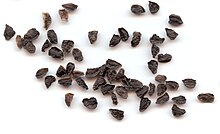Aconitum napellus
| Aconitum napellus | |
|---|---|

| |
| Scientific classification | |
| Kingdom: | Plantae |
| Clade: | Tracheophytes |
| Clade: | Angiosperms |
| Clade: | Eudicots |
| Order: | Ranunculales |
| Family: | Ranunculaceae |
| Genus: | Aconitum |
| Species: | A. napellus
|
| Binomial name | |
| Aconitum napellus | |
Aconitum napellus, monkshood,
Cultivation
Aconitum napellus is grown in gardens in
Subspecies
Nine subspecies are accepted by the Flora Europaea:[5]
- Aconitum napellus subsp. napellus, south-western Britain
- Aconitum napellus subsp. corsicum (Gáyer) W.Seitz, Corsica
- Aconitum napellus subsp. firmum (Rchb.) Gáyer, Central and eastern Europe (declared as an own species Aconitum firmum[6])
- Aconitum napellus subsp. fissurae (Nyár.) W.Seitz, Balkans to south-western Russia
- Aconitum napellus subsp. hians (Rchb.) Gáyer, Central Europe
- Aconitum napellus subsp. lusitanicum Rouy, south-western Europe
- Aconitum napellus subsp. superbum (Fritsch) W.Seitz, western Balkans
- Aconitum napellus subsp. tauricum (Wulfen) Gáyer, Eastern Alps, southern Carpathians (declared as an own species Aconitum tauricum by other sources[7][8])
- Aconitum napellus subsp. vulgare (DC.) Rouy & Foucaud, Alps, Pyrenees, northern Spain
Uses
Aconitum napellus is grown in gardens for its attractive spike-like inflorescences and showy blue flowers.[9] It is a cut flower crop used for fresh cutting material and sometimes used as dried material. The species has a low natural propagation rate under cultivation and is propagated by seed or by removing offsets that are generated each year from the rootstocks. The use of micropropagation protocols has been studied.[10] This species has been crossed with other Aconitums to produce attractive hybrids for garden use, including Aconitum × cammarum.[11]

Like other species in the genus, A. napellus contains several
Toxicology
Marked symptoms may appear almost immediately, usually not later than one hour, and "with large doses, death is almost instantaneous".
Treatment of poisoning is mainly supportive. All patients require close monitoring of
Poisoning may also occur following picking the leaves without wearing gloves; the aconitine toxin is absorbed easily through the skin. In this event, there will be no gastrointestinal effects. Tingling will start at the point of absorption and extend up the arm to the shoulder, after which the heart will start to be affected. The tingling will be followed by unpleasant numbness. Treatment is similar to poisoning caused by oral ingestion and even handling the plant without gloves has been reported to result in multi-organ failure and death.[24][25]
The plant's chief toxic component, aconitine, is a potent neurotoxin that opens tetrodotoxin sensitive sodium channels.[26] It increases the influx of sodium through these channels and delays repolarization, thus increasing excitability and promoting ventricular dysrhythmias.[26]
References
- . Retrieved 19 November 2021.
- ^ BSBI List 2007 (xls). Botanical Society of Britain and Ireland. Archived from the original (xls) on 2015-06-26. Retrieved 2014-10-17.
- ^ "Aconitum Sparks Variety". Let's Go Planting. Retrieved 8 April 2024.
- ^ Bourne, Val (31 July 2009). "How to grow: Aconitum 'Sparks Variety'". The Telegraph. Retrieved 7 June 2020.
- ^ Flora Europaea: Aconitum napellus
- ^ "Aconitum firmum Rchb. | Plants of the World Online | Kew Science". Plants of the World Online. Retrieved 2023-10-26.
- ^ The Plant List (KEW): Aconitum tauricum (2018-05-03)
- ^ Jäger et al.: Rothmaler - Exkursionsflora von Deutschland, Bd. 2. Ed. 20, Spektrum akadem. Verlag.
- ^ Datta, Subhash Chandra. 1988 Systematic botany. New Delhi: Wiley Eastern Ltd.
- ISSN 1432-203X(online), Volume 14, Number 6 / March 1995, DOI 10.1007/BF00238594, pages 345–348
- ^ Armitage, A. M. 2000. Armitage's garden perennials a color encyclopedia. Portland, Oregon: Timber Press. Pages 19–20.
- ^ J Ethnopharmacol. 1981 Nov;4(3):247-336. Arrow poisons in China. Part II. Aconitum--botany, chemistry, and pharmacology. Bisset NG.
- ^ Luke DeMaitre Medieval Medicine: The Art of Healing, from Head to Toe (2013), p. 67, at Google Books
- ^ "Toxicology in the Old Testament: Did the High Priest Alcimus Die of Acute Aconitine Poisoning?" Authors: Moog F.P.1; Karenberg A.1 Source: Adverse Drug Reactions & Toxicological Reviews (now known as Toxicological Reviews), Volume 21, Number 3, 2002 , pp. 151–156(6) Publisher: Adis International
- ^ Roberts, M. F., and Michael Wink. 1998. Alkaloids biochemistry, ecology, and medicinal applications. New York: Plenum Press. Page 18.
- ^ CSA Archived December 8, 2008, at the Wayback Machine
- ^ Gary Lovisi and Marvin Kaye The Great Detective: His Further Adventures: A Sherlock Holmes Anthology (2012), p. 55, at Google Books
- ^ R.D. Mann Modern Drug use: An Enquiry on Historical Principles (1984), p. 66, at Google Books
- ^ a b The Extra Pharmacopoeia Martindale. Vol. 1, 24th edition. London: The Pharmaceutical Press, 1958, page 38.
- ^ a b One or more of the preceding sentences incorporates text from a publication now in the public domain: Chisholm, Hugh, ed. (1911). "Aconite". Encyclopædia Britannica. Vol. 1 (11th ed.). Cambridge University Press. pp. 151–152.
- ^ S2CID 2697673.
- S2CID 218856921.
- PMID 15111916.
- ^ "Gardener Nathan Greenway 'died after handling deadly plant'". BBC News. BBC. 7 November 2014. Retrieved 7 November 2014.
- ^ "Gardener dies 'after brushing against deadly wolfsbane flower' on millionaire's estate". Independent. 11 November 2014. Archived from the original on 2014-11-07. Retrieved 2 February 2015.
- ^ PMID 1475787.
External links
- Imazio M, Belli R, Pomari F, Cecchi E, Chinaglia A, Gaschino G, Ghisio A, Trinchero R, Brusca A (2000). "Malignant ventricular arrhythmias due to Aconitum napellus seeds". Circulation. 102 (23): 2907–8. PMID 11104752.

